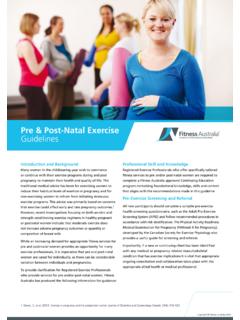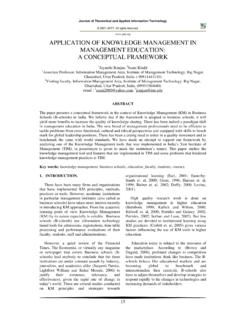Transcription of Trends in Fitness
1 Profile of the Fitness Industry in AustraliaTrends in Fitness ContentsSection 4: Trends in Fitness Current Trends 3 Future Trends 5 Future Trends in Fitness as viewed by Fitness Australia registrants 82 Profile of the Fitness Industry in Australia The 24-hour gym is in many ways the logical extension and apex of consumer calls for more flexibility in their options for belonging to a Fitness opened its first 24/7 branch in 2007; Anytime Fitness opened theirs in 2008. The founders of both businesses describe the gym market at the time of their entry as dominated by inflexible and expensive full-service chains, and their model of anytime access to all club locations, with more flexible and lower cost entry, has successfully met a need for many Australians. By 2013, these two businesses were among the fastest growing franchise businesses in Australia, and they now have hundreds of branches nationwide.
2 Eventually, dominant full service chains culled underperforming locations, and started to make changes to their business models to adapt to the new demand for Trends The 24/7 phenomenonAlmost a decade on from the entry of 24/7 gyms to the Australian marketplace, there is still a tension among professionals around which model full-service or bare bones best meets the needs of Australian Fitness consumers, and a number of industry professionals think that while convenience and low cost has its place, the appeal of personal service cannot be counted out. It is worth noting that Anytime Fitness , one of the early Fitness disruptors, appears to be balancing both imperatives. Its website promotes the availability of personal training to its members at all times, and projects the image of a full-service gym that happens to be open around the clock.
3 We don t buy into the current trend which is all about having boxes of kit and just wishing people the best of luck when you show them in there. Andy Cosslett, global chief executive of Fitness First, quoted in The Sydney Morning Herald in April 2014 It s not actually about having people use the gym in the hours of 10pm to 5am only about 5% of the membership base will do that it s about reducing the costs. But as a result of these gyms, we see a declining membership cost overall they re driving the whole industry prices down. Rather than trying to compete on price, these full service clubs should be marketing themselves on the advantages of the full service. Industry leader interview, 2015 Fitness Australia I think in the next 5-10 years, we ll see the 24-hour gyms plateau a bit there ll be a market for those who want to come back to a full service model.
4 Industry leader interview, 2015 Fitness Australia Few think that the 24 hour gym is going away (79% of Fitness professionals think they are going to be around for the long term), and such services will certainly continue to cater to the market of those who are time-poor during regular business hours, self-motivated, and Fitness -confident individuals. However, there is also still a cohort of Fitness consumers who will prefer a more personal full-service model, provided it is offered with sufficient flexibility. Full-service can be thought of as a niche in itself the challenge will be to balance the traditionally small size of a niche (as opposed to mass) market with the costs of operating a full service last few years have seen the rise of fit and attractive young people marketing their own exercise and diet programs directly to a customer base maintained through social media.
5 Almost half of the registered Fitness professionals surveyed by Fitness Australia in 2015 believe that Instagram-based Fitness personalities are a fad that will not last much longer; however, the potential for revenue in this business model combined with the relatively low barriers to entry, will likely make this an attractive prospect for many. The lucky few will be those who put together the right package to make it work. Opinion of what this trend means for the Fitness industry is mixed, and in some ways is dependent on the ways in which Fitness professionals are already operating. Current Trends The Insta-fit All types of Fitness professionals ( Fitness businesses, sole traders, exercise professionals, and even students) admit to concern that the lack of qualifications of many social media Fitness personalities is a potential source of damage to the Fitness industry, and sole traders in particular see them as a threat to their business (58% somewhat or completely agreed that people will use these social media Fitness guides and programs rather than coming to a gym or seeing a trainer).
6 However, while sole trading businesses may be threatened by these personalities, they and students are also looking at them and seeing opportunities 60% of sole trading businesses and 58% of students believe that these social media business models will provide them with new income streams. Fitness businesses, in comparison, and the exercise professionals they employ, are less likely to see financial benefits in these new models. Interestingly, although many sole trading businesses appear to be seeing a possible source of revenue in these channels, current Fitness businesses and personal trainers estimate that only about 10% of their membership or clientele came to them via contact made on social media direct, in-person word of mouth is still overwhelmingly relied on to generate the business of training people. Together this may indicate scope for Fitness professionals to refocus on social media strategies the success of the Insta-fit demonstrates that there is a demand for online Fitness services.
7 The challenge is for more Fitness businesses to find a way to them and to educate the audience in terms the quality of and the qualifications behind the advice. 4 Profile of the Fitness Industry in Australia Efficient fitnessThe Worldwide Survey of Fitness Trends for 2015 placed body weight training and high-intensity interval training (HIIT) at the top of the list for predicted Fitness industry Trends . Part of the appeal of both of these forms of exercise are their efficiency: body weight training requires little in the way of equipment, making it cost-effective; HIIT exercise sessions are typically short, making them ideal for time-poor adults who want the most bang for their buck out of their training. Functional training is another efficient type of Fitness gaining in per cent of Fitness professionals surveyed by Fitness Australia in 2015 believe that body weight training/functional training are Trends rather than fads, and 84% feel the same way about HIIT.
8 The increased desire for HIIT style training can be seen reflected not only in the revamped fit-outs of many mainstream gyms, but also in the commercialisation of niche models such as F45 Fitness . The Australia-based F45 Fitness model as at June 2015, has 277 franchises worldwide (predominantly Australian, but also in New Zealand, the USA, India, and the UK), reflecting consumer demand for functional, efficient Fitness , and representing a further competitor to the traditional gym Trends Within industryNiche/specialised trainingPopulation growth in general brings with it increases in the size of sub-populations. Key in the context of Australia and the Fitness industry is the anticipated population growth of older people, people who are overweight or obese, women, and Australians from different cultural backgrounds. Each of these sub-populations represents a market for the Fitness industry to approach in a manner that is unique to the needs of that standards for educationIn most industries that require a qualification, there comes a point where there are so many graduates with that qualification that additional points of differentiation need to be sought (for example, a Bachelor degree no longer has the same cachet it once did; an Honours or Masters is needed to put an applicant above the pack, and even that may not be different enough).
9 In the Fitness industry, the influx of professionals with Certificate III and IV, combined with negative industry perceptions of the quality of their qualification, is likely to create just such a situation. At some point in the future, a shift will be needed to return value to the addition to this, it is likely that in coming years, Fitness services will be brought to bear on Australians specifically to address their health issues, meaning that higher standards will be expected or required of Fitness instructors and personal trainers who are working with these people. In particular, if someone has been referred to a Fitness professional by a health professional, the health professional is likely to have certain requirements as to the qualification of the Fitness professional to whom they are entrusting their populations The increasing number of older Australians will widen two markets for Fitness consumers older Australians who have a history of involvement in Fitness activities and will continue to use these services as they age, and older Australians who may not have participated in Fitness in the past, but will be directed to do so for the health benefits.
10 Both groups are likely to require the services of Fitness professionals to provide advice on age appropriate exercising. The ageing Australian population will also contain ageing Fitness professionals (older Fitness professionals are currently a very small proportion of Fitness professionals, and particularly Fitness instructors).Increasingly unhealthy populations Australia has one of the highest rates of overweight and obesity in the world. This brings with it a large share of the population with the need and/or desire to lose weight and to increase their levels of physical activity. In particular, an overweight or obese individual is likely to require specific guidance in order to make their exercise activities effective in making improvements to their health, linking to a need for Fitness professionals. While the overweight and obese who are directed or motivated to participate in Fitness in the future will generate demand for Fitness professionals, it should also be noted that there will also be a cohort of the overweight and obese for whom their condition presents them with obstacles to participating in Fitness they may feel their health is too poor, that it is too hard or unpleasant to exercise, feel too embarrassed to go to a gym, or that even accessing a Fitness facility is too difficult.








